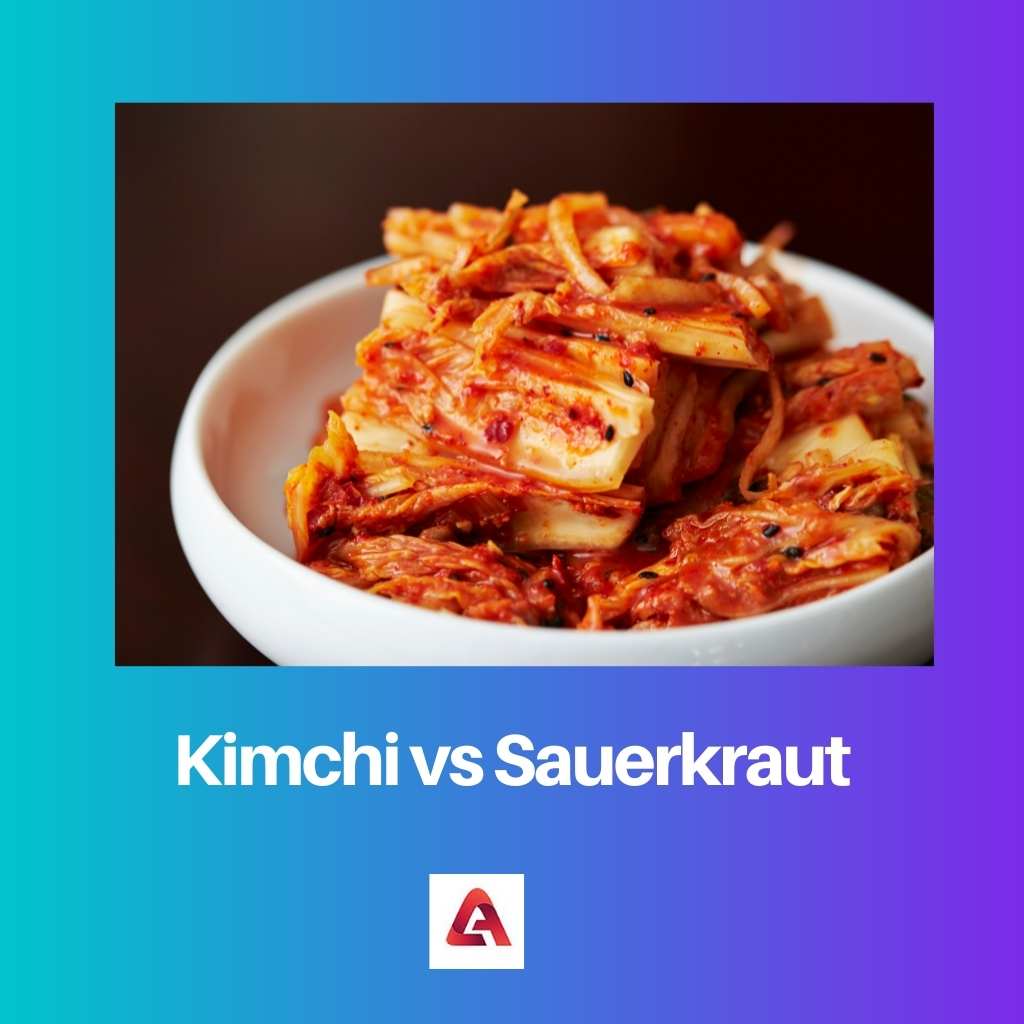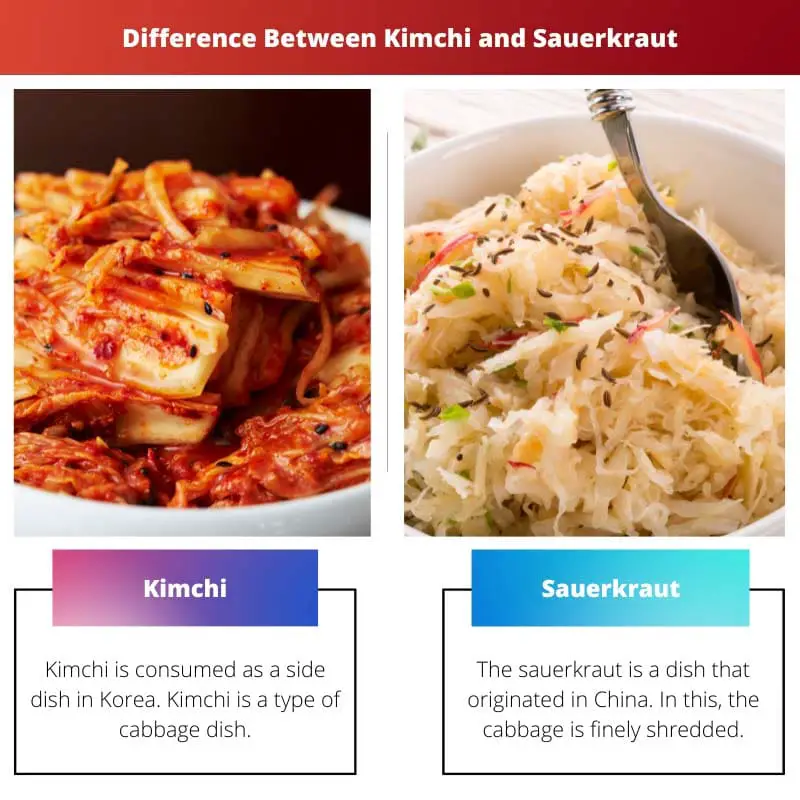There are several dishes that are consumed by human beings all over the world. Almost all species of plants are consumed as food in many countries globally.
One of the vegetables that are quite famous is cabbage. It can be eaten as a normal vegetable but spice things up. Many people like to consume pickles.
The pickles made from cabbage have two different names, methods, and tastes: “kimchi” and “sauerkraut.”
Key Takeaways
- Kimchi is a Korean fermented cabbage dish seasoned with spices, garlic, and chili peppers, while sauerkraut is a German fermented cabbage dish flavored with salt and sometimes caraway seeds.
- Kimchi has a spicy, tangy taste, whereas sauerkraut has a sour, acidic flavor.
- Both kimchi and sauerkraut offer numerous health benefits due to their probiotic content, which promotes gut health and supports the immune system.
Kimchi vs Sauerkraut
The difference between kimchi and sauerkraut is that kimchi originated in Korea and is consumed as a side dish in Korea. They are fermented with many vegetables and salt. On the other hand, sauerkraut has its main origin in china. The raw cabbage is cut and is fermented with many acidic lactic bacteria.

Kimchi is consumed as a side dish in Korea. Kimchi is a type of cabbage dish which is fermented with many types of seasonings and spices to give a spicy flavour.
The main ingredients, which are the reason for the great taste of the kimchi, are ginger, garlic, and many other types of Korean spices.
The sauerkraut is a dish that originated in China. In this, the cabbage is finely shredded. After the completion of shredding proper, the cabbage is kept for fermentation.
Due to its name, many people think that it has come from Germany, but it is wrong. After getting popularity, this dish was also opted by the Central European Cultures.
Comparison Table
| Parameters of Comparison | Kimchi | Sauerkraut |
|---|---|---|
| Origin | It has originated from Korea. | It is originated in China. |
| Cabbage consistency | The whole leaves or the chinks of the cabbage is used. | The cabbage is finely shredded at the initial step. |
| Brining | This process is used to absorb the extra moisture from the cabbage, and the brine solution is discharged before they are kept for the process of fermentation. | The brine solution is formed during fermentation, which helps in converting sugars to starch. |
| Fermentation time (room temperature) | It requires about one to two days for the fermentation process at room temperature. | It requires about five days to two weeks for the fermentation process at room temperature. |
| Final texture | After the complete process, the final texture is crunchy. | After the complete process, the final texture is soft. |
What is Kimchi?
The kimchi is the traditional side dish of Korea, which is formed by adding salt for the fermentation of vegetables like napa cabbage, and Korean dishes.
A variety of seasons are used on the vegetables in dishes: spring onion, garlic, ginger, jeotgal (type of salted seafood), gochugaru( type of Korean chilli powder).
This is consumed as a side dish and used in different types of soups and strew, which enhances the taste of the food and is a staple food in the Korean diet.
There is a wide range of kimchi made which different tastes, vegetables, and seasonings. The winter kimchi is also known as kimjang, which were stored in the late vessels for fermentation knowns as “onggi”.
Making kimchi is not a long process as the cabbage are simply cut pr peeled just before the bringing process.
The salt known as bringing salt is added to the kimchi at the initial step as part of the main ingredient for absorbing the extra water and making them dry for future processes. This step is the reason for bringing the natural flavours in the vegetables.
The brining process should be done for 12 hours at 5% to 7% salinity or for 7 hours at 15% salinity. The time period and the salinity for the fermentation are changed.

What is Sauerkraut?
The sauerkraut is a type of dish which has had its origin in China for several years. It is basically made with finely shredded cabbage before the process of fermentation.
The two types of cabbage used to prepare this dish are red cabbage and green cabbage. However, the most common used cabbage is green cabbage.
There are many types of sauerkraut that are made with various spices, but the basic sauerkraut is made only with cabbage. It also needed a proper amount of time to get a proper taste accordingly.
If you need to try some extra variation, shredded apple, carrots, bell pepper, and beets can be added to give extra flavour.
The preparation of sauerkraut is quite long as it needs to be kept in layers after shredding the cabbage with a pinch of salt.
The fermentation process is about five days to several months because the fermentation for sauerkraut takes place in three phases. After the complete procedure, this long fermentation makes acidic and tart with a soft texture.

Main Differences Between Kimchi and Sauerkraut
- The kimchi has originated from Korea, whereas sauerkraut originated from China.
- In kimchi, cabbage is added with many other flavoring spices, whereas in sauerkraut, it is only made with cabbage and salt.
- The kimchi is chopped as a whole or in chunks, but the sauerkraut is finely chopped.
- In kimchi, the fermentation process is about one to two days only. On the other hand, in sauerkraut, the fermentation process is quite long, about five days to several weeks.
- The final texture of the kimchi is crunchy with spicy, salty, and sour taste, but the final texture of the sauerkraut is soft with an acidic and tart taste.

- https://journals.asm.org/doi/abs/10.1128/jmbe.v15i2.695
- https://journals.asm.org/doi/abs/10.1128/AEM.01859-10
- https://www.sciencedirect.com/science/article/pii/S0308814600001412
